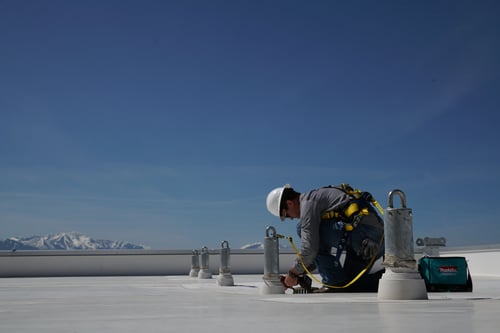Government Buildings
Federal, state, and local government buildings have much in common with industrial and commercial properties. Leaking and worn roofs need to be repaired and replaced. And rooftop HVAC equipment, venting stacks, and air handlers require periodic inspection and maintenance. Contrary to widespread belief, government installations are subject to the same OSHA fall protection regulations applied to the commercial and industrial market sectors. With this said, government buildings present an additional set of challenges to fall protection companies that must be met to reconcile safety concerns with homeland security considerations.
We are a complete turnkey provider of OSHA compliant fall protection systems and have years of design and installation experience in the government market sectors. Contact us for expert assistance with your requirements for fall restraint systems, fall arrest equipment, and other fall protection.

Fall Protection Solutions
Design Considerations
The effective use of guardrail is a significant design consideration for many government buildings. In many rooftop applications for this market sector, guardrail needs to blend into the overall building design. As a result, stainless steel and hot dipped galvanized guardrail is used instead of the powder coated safety yellow guardrail commonly found in commercial and industrial applications. For installations with parapet walls higher than 21', there is no need for a midrail. A top rail can be permanently attached to the parapet wall at 42'.
Overall fall restraint system design needs to take into consideration that many government buildings are constructed to withstand terrorist attacks. As such, these concerns will influence material selections and system configuration.
Single point anchors are rated at 5,000 or 10,000 lbs — or 2 times the applied load in the event of a fall by a qualified person. A single point anchor may be designed for single or dual tie-off as long as each user attaches to a designated D-ring. Multiple users should never tie off to the same D-ring under any circumstances.
Rooftop single point anchors can be used in conjunction with a variety of deck substrates including metal standing seam, rubber membrane, or concrete. An SPA is designed to protect workers within a 30-degree conical cone; moving outside the intended coverage area increases the likelihood of coming into contact with structure below the work area in the event of a swing fall.
Horizontal lifelines designated for rooftop use are typically constructed from corrosion resistant stainless steel components for maximum service life. Our fall protection safety specialists can engineer a horizontal lifeline system to accommodate the special characteristics of your rooftop, from corners to the absence of pre-existing anchor points and more.
Although the horizontal lifeline system may seem simple in function and design, special care must be taken to account for the loads on various anchor points and deflection in the event of a fall. Each anchor point must be secure enough to withstand the forces associated with a fall. A thorough review of the work area is needed to ensure that a worker will not strike pipes, equipment, or other surfaces when falling. Load and deflection rates are determined by a number of factors, including pre-tension of the cable, length of the area spanned by the horizontal lifeline, and the number of workers connected to the system.
If you have questions about fall restraint systems products or fall arrest equipment, reach out to our fall protection specialists today.

b-1.jpg?width=1368&height=1340&name=Rail%20(175)b-1.jpg)




.webp?width=453&height=549&name=Confined%20Space%20and%20Rescue%20-%20In%20Applications%20(13).webp)

